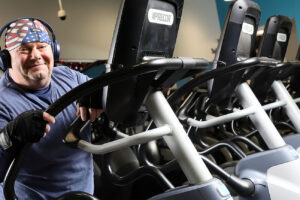Long-Time First Responder Marks Another First
Bart Amburgey, an 87-year-old lifelong resident of New Egypt, is considered by many as a legend in his hometown. Earning the nickname “Father Bart” for his reputation as a role model and storyteller, he has volunteered in his community throughout his life—including 47 years with the first aid squad and 50 years with the fire company. Even his idea years ago to start a collection of camel figurines eventually evolved into “mascot” status for the first responder vehicles.
After helping others for so many years, Bart found himself on the other side of the health care experience last fall. Abdominal symptoms led him to CentraState’s Emergency Department and an overnight stay at the medical center for testing. When board-certified surgeon Amit Kharod, MD, reviewed Bart’s CT scan results, several gall stones were evident. But he also noticed a more serious issue: an aortic aneurysm and two iliac aneurysms, one of which was life-threatening.
The Complexity of Aneurysm Repair
Aneuryms are weak, bulging areas in the arteries that can be fatal if they rupture. Iliac aneurysms affect the iliac arteries, a group of arteries that branch down from the aorta to supply blood to the pelvic area.
“My motto has always been that if something’s wrong, let’s fix it,” Bart says. “I knew how serious it was because I’ve brought people with aneurysms to the Emergency Department in the past.”
Until recently, repair of complex iliac aneurysms like Bart’s required either open surgery or endovascular (minimally invasive) surgery, which would cut off blood flow to pelvic organs during the procedure. Thankfully, Bart had another option.
Dr. Kharod referred him to Tushar Tripathi, MD, a board-certified vascular surgeon at CentraState and one of only a handful of surgeons in the region performing iliac branch endograft repair of iliac aneurysms. This involves using special stent grafts (tube-like devices) that are shaped like pants and designed to reinforce the walls of the iliac arteries while preserving blood flow to the pelvic area during the surgery.
“Previous endovascular options often resulted in impotence, buttock pain, and impaired healing with any future pelvic surgeries, such as prostate surgery,” Dr. Tripathi explains. “This new approach avoids these complications while enabling a much faster recovery than traditional open surgery.”
Bart’s procedure marked the first bilateral (on both sides) iliac endograft repair performed at CentraState. Bart’s wife, Janet, and his four children—who were all by his side after the surgery—are extremely relieved that the aneurysms were found and successfully repaired.
“We’re thankful that Dr. Kharod sent us on the right path to Dr. Tripathi,” says Janet. “It’s almost like it was meant to be.”
“We have nothing but great things to say about both doctors,” adds Bart’s daughter, Karla. “We’re so glad that Dad is doing well and back to telling all his stories.”
For more information about aneurysm surgery or other endovascular interventions at CentraState’s Cardiac and Endovascular Lab, visit or to schedule an appointment, call 866-CENTRA7 (866-236-8727).





